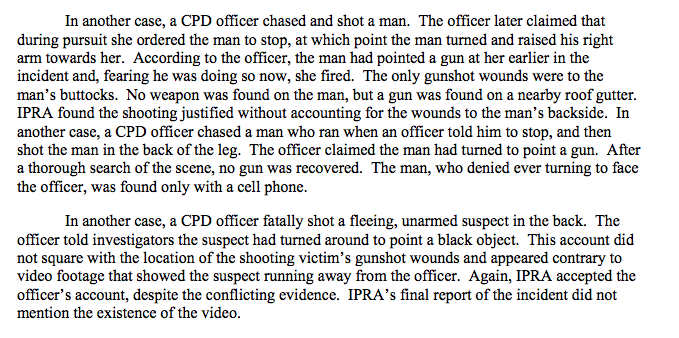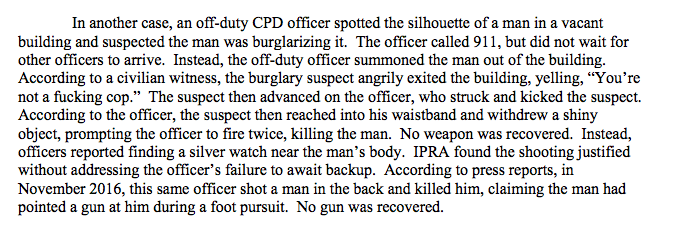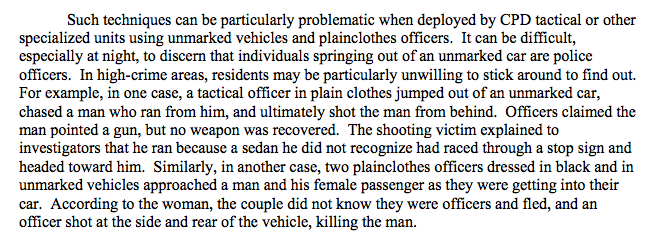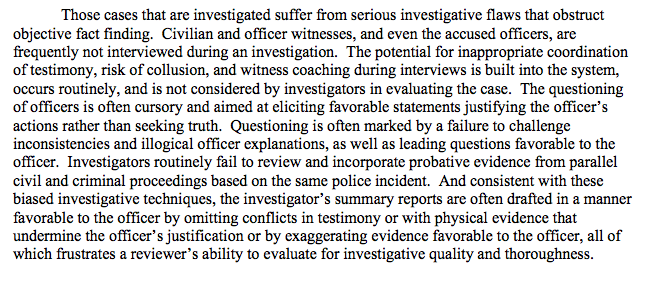The Department of Justice published a scathing report Friday about unconstitutional policing in Chicago, announcing after a 13-month investigation that the city’s cops have engaged “in a pattern or practice of using force, including deadly force.”The DOJ report is based on hundreds of interviews with cops, police officials, and citizens, and includes scrutiny of 170 officer-involved shooting investigations and more than 400 incidents in which “less-lethal force” was used.Here are five of the most outrageous findings from the report:1. Shooting suspects who pose “no immediate threat to officers or the public”
The DOJ found “numerous incidents” in which Chicago police officers “chased and shot fleeing persons who posed no immediate threat to officers or the public.”“Almost without exception,” the DOJ wrote, “officers’ reports of these events were accepted at face value, even where there was contrary evidence.”There was one example in which police fired 45 rounds at a man on a residential street:
 2. Fatally shooting unarmed suspects in the back — and having it ruled justified
2. Fatally shooting unarmed suspects in the back — and having it ruled justified
There are multiple cases in which Chicago cops shot suspects in the back, only to have investigators say the shooting was justified. Two incidents cited in the report: 3. Mistaking a wristwatch for a weapon before fatally shooting the suspect
3. Mistaking a wristwatch for a weapon before fatally shooting the suspect
The report describes an incident in which an off-duty officer confronted a burglary suspect. The suspect reportedly said, “You’re not a fucking cop,” and approached the officer, who was not in uniform, leading to a deadly confrontation: 4. Shooting suspects who run from plainclothes cops jumping out of unmarked cars with guns drawn
4. Shooting suspects who run from plainclothes cops jumping out of unmarked cars with guns drawn
The report describes how Chicago cops use a technique called a “jump-out,” in which “groups of officers, frequently in plain clothes and riding in unmarked vehicles driving rapidly toward a street corner or group of individuals and then jumping out and rapidly advancing, often with guns drawn.”These actions often cause one or more members of the targeted group to walk away briskly or run from the scene. The officers then zero in on the fleeing person, with one officer often tasked with chasing him on foot. Some of the most problematic shootings occurred when that officer closed in on the subject, greatly increasing the risk of a serious or deadly force incident. 5. Only 2 percent of complaints against cops leading to punishment
5. Only 2 percent of complaints against cops leading to punishment
The DOJ reports that the City of Chicago received more than 30,000 complaints of police misconduct in the five years that preceded the investigation, but only 2 percent of those complaints were sustained, meaning officers went unpunished 98 percent of the time. The report describes a deeply flawed investigative process in cases of officer misconduct, and a “code of silence” that discourages cops from speaking out against their peers.“The questioning of officers is often cursory and aimed at eliciting favorable statements justifying the officer’s actions rather than seeking truth,” the DOJ wrote. “Questioning is often marked by a failure to challenge inconsistencies and illogical officer explanations, as well as leading questions favorable to the officer.” Read more about the DOJ investigation and how Chicago plans to reform its police department here. The full DOJ report can be found here.
Read more about the DOJ investigation and how Chicago plans to reform its police department here. The full DOJ report can be found here.
Advertisement
The DOJ found “numerous incidents” in which Chicago police officers “chased and shot fleeing persons who posed no immediate threat to officers or the public.”“Almost without exception,” the DOJ wrote, “officers’ reports of these events were accepted at face value, even where there was contrary evidence.”There was one example in which police fired 45 rounds at a man on a residential street:


There are multiple cases in which Chicago cops shot suspects in the back, only to have investigators say the shooting was justified. Two incidents cited in the report:

The report describes an incident in which an off-duty officer confronted a burglary suspect. The suspect reportedly said, “You’re not a fucking cop,” and approached the officer, who was not in uniform, leading to a deadly confrontation:

The report describes how Chicago cops use a technique called a “jump-out,” in which “groups of officers, frequently in plain clothes and riding in unmarked vehicles driving rapidly toward a street corner or group of individuals and then jumping out and rapidly advancing, often with guns drawn.”
Advertisement

The DOJ reports that the City of Chicago received more than 30,000 complaints of police misconduct in the five years that preceded the investigation, but only 2 percent of those complaints were sustained, meaning officers went unpunished 98 percent of the time. The report describes a deeply flawed investigative process in cases of officer misconduct, and a “code of silence” that discourages cops from speaking out against their peers.“The questioning of officers is often cursory and aimed at eliciting favorable statements justifying the officer’s actions rather than seeking truth,” the DOJ wrote. “Questioning is often marked by a failure to challenge inconsistencies and illogical officer explanations, as well as leading questions favorable to the officer.”
